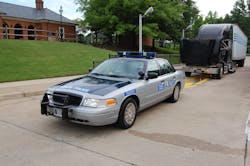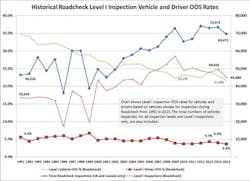Vehicle OOS rate falls over full percentage point during Roadcheck 2015
The results from Roadcheck 2015 – the annual 72-hour safety enforcement “blitz” conducted across North America and overseen by the Commercial Vehicle Safety Alliance (CVSA) and Federal Motor Carrier Safety Administration (FMCSA) in the U.S. – indicated yet another downturn occurred for vehicles being placed out-of-service (OOS) overall, over a full percentage point drop, though they were up among Level I inspections.
By the same token, commercial driver violations were down in the Level I inspection category when compared to the event’s 2014 data.
Conducted between June 2 and 4 this year, Roadcheck 2015 encompassed 69,472 truck and bus inspections, with 44,989 of them Standard Level I Inspections, which are the most rigorous type.
For the overall number of inspections in 2015, the driver OOS rate stayed the same when compared to 2014: right at 4.8%. Out of the Level I grouping, though, inspectors cited 1,623 drivers or 3.6% of the total with violations, compared to 4% among Level I inspections cited in 2014.
Out of the overall number of inspections, 17.5% of vehicles were placed out of service; a steep decline from the 18.7% OOS rate from Roadcheck 2014. Among Level 1 inspections, 21.6% of vehicles were placed out of service compared to 23% in 2014, CVSA said.
CVSA also noted that 777 citations were issued during Roadcheck 2015 for seatbelt violations.
The group added that inspectors placed a special emphasis on cargo securement during the annual Roadcheck blitz this year and issued 2,439 load securement violations.
The leading citations, ranked in order of the most common, were:
- Failure to prevent shifting/loss of load
- Failure to secure truck equipment such as tarps, dunnage, doors, tailgates, spare tires;
- Damaged tie downs, typically for unacceptable wear on chain or cuts and tears on web straps;
- Insufficient tie downs;
- And finally loose tie downs.
“We must remember that the work done over that 72-period represents only a fraction of what’s accomplished every day by approximately 13,000 CVSA-certified local, state, provincial, territorial and federal inspectors at hundreds of inspection locations across North America,” noted CVSA Acting Executive Director Collin Mooney. “They work every day to keep our roads safe.”
About the Author
Sean Kilcarr
Editor in Chief
Sean Kilcarr is a former longtime FleetOwner senior editor who wrote for the publication from 2000 to 2018. He served as editor-in-chief from 2017 to 2018.

